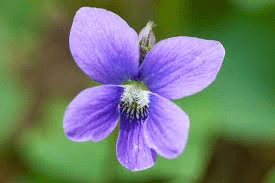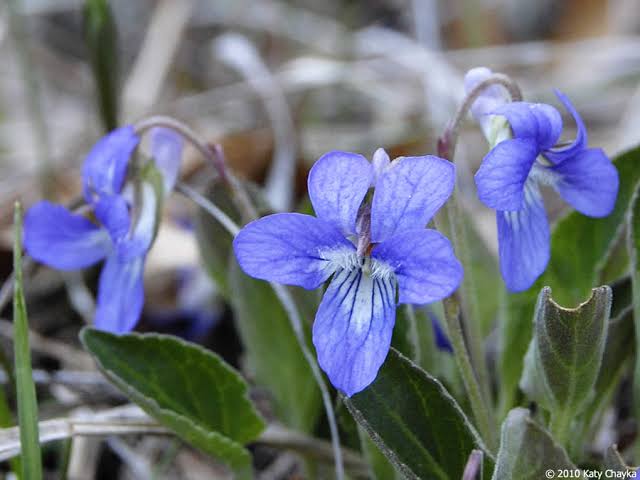Viola adunca, commonly known as the hookedspur violet, is a delicate and charming perennial plant native to North America. This lovely wildflower is part of the Violaceae family and is distinguished by its distinctive characteristics.
ts heart-shaped leaves and vibrant purple to lavender flowers with conspicuous hooked spurs at the base give it a unique appearance that’s hard to miss in the wild. Viola adunca can be found in a variety of habitats, from meadows and woodlands to stream banks, and it blooms in the early spring, adding a splash of color to its surroundings.
This violet species plays an essential role in the ecosystem as a source of nectar for pollinators like butterflies and bees. The sweet fragrance of its blossoms attracts these insects, making it a valuable contributor to local biodiversity. Viola adunca also has a long history of traditional medicinal use among Native American tribes. Its roots were often employed for their potential healing properties, and they were believed to treat various ailments.
Garden enthusiasts appreciate Viola adunca for its aesthetic appeal and adaptability to a range of soil types and light conditions. This wildflower can be an attractive addition to home gardens, where it can thrive in both sunny and partially shaded areas. With its elegant appearance and ecological significance, Viola adunca is a captivating species that enriches the natural landscape and offers gardeners a delightful, low-maintenance option for their outdoor spaces.
The Botanical Description of Viola adunca
Viola adunca, commonly known as the hookspur violet or early blue violet, is a delicate perennial plant belonging to the Violaceae family. This enchanting wildflower is characterized by its distinctive features:
1. Leaves and Stem: Viola adunca typically boasts heart-shaped leaves with serrated edges. The stem of this plant is slender, often measuring between 5 to 15 centimeters in height.
2. Flowers: The flowers of Viola adunca are a sight to behold. They bloom early in the spring, displaying striking violet or lavender petals. The lower petal, adorned with distinct dark lines, acts as a guide for pollinators. The delicate fragrance of the flowers further adds to their allure.
3. Root System: Viola adunca develops a fibrous root system that helps anchor the plant securely in the soil.
4. Habitat: This species of violet is commonly found in meadows, woodlands, and open grassy areas. It prefers well-drained soil and partial shade, making it a common sight in diverse habitats across certain regions.
The Geographic Distribution of Viola adunca
1. North America: Viola adunca is native to North America, specifically flourishing in regions such as the Pacific Northwest, western United States, and parts of Canada. It can be spotted in states like Washington, Oregon, California, Idaho, and Montana.
2. Habitat Preference: Within these regions, Viola adunca thrives in various environments, including damp woodlands, alpine meadows, and grassy slopes. Its ability to adapt to different habitats contributes to its widespread distribution.
3. Ecological Importance: Viola adunca plays a role in the ecosystem by providing nectar for pollinators like bees and butterflies. Additionally, its leaves serve as food for certain caterpillar species, showcasing its ecological significance.
The Chemical Composition of Viola adunca
The chemical composition of Viola adunca has been of interest to researchers and herbal enthusiasts alike. While this violet species contains a variety of compounds, including flavonoids and alkaloids, it’s essential to note that detailed studies on its chemical constituents are ongoing. Here are some key components found in Viola adunca:
1. Flavonoids: Viola adunca is rich in flavonoids, which are known for their antioxidant properties. These compounds contribute to the plant’s vibrant color and may have potential health benefits.
2. Alkaloids: Certain alkaloids have been detected in Viola adunca, although their specific types and concentrations can vary. Alkaloids often have biological activities and may influence the plant’s interactions with other organisms in its environment.
3. Mucilage: Viola adunca contains mucilage, a gel-like substance found in various plant parts. Mucilage can have soothing properties and is often used in traditional herbal remedies.
4. Anthocyanins: The violet and lavender hues of Viola adunca flowers are attributed to anthocyanins, a group of flavonoid pigments. These compounds have antioxidant and anti-inflammatory potential.
While Viola adunca’s chemical composition is fascinating, it’s crucial to approach the plant with respect and, if considering medicinal uses, seek guidance from experts due to the variation in chemical profiles among different populations of the species.
Read Also: 10 Medicinal Health Benefits of Osmorhiza longistylis (Sweet cicely)
The Medicinal Health Benefits Of Viola adunca (Hookspur Violet)

1. Respiratory Health: Viola adunca has a history of traditional use in herbal medicine to alleviate respiratory issues. The plant is believed to have properties that can help soothe coughs and relieve symptoms of respiratory infections.
2. Anti-Inflammatory Effects: The hookspur violet contains compounds with potential anti-inflammatory properties. It may be used in herbal remedies to address various inflammatory conditions, although more research is needed.
3. Wound Healing: Some herbalists have utilized Viola adunca for its potential wound-healing properties. It may be applied topically to minor cuts and bruises to promote healing and reduce inflammation.
4. Antioxidant Support: Viola adunca’s flavonoid content contributes to its antioxidant potential. Antioxidants can help protect the body from oxidative stress and may play a role in overall health.
5. Mild Laxative: In herbal medicine, Viola adunca is sometimes used as a mild laxative to address constipation. It is believed to have a gentle and non-irritating effect on the digestive system.
The Methods of Usage to Achieve the Provided Health Benefits Of Viola adunca (Hookspur Violet)
1. Herbal Infusion: Prepare a herbal infusion by steeping dried Viola adunca leaves and flowers in hot water. This can be consumed as a tea for respiratory health and to benefit from its potential antioxidant properties.
2. Poultice: To harness its wound-healing potential, create a poultice by mashing fresh or dried Viola adunca leaves and applying them to minor cuts or bruises. This method may help reduce inflammation and promote healing.
3. Tinctures and Extracts: Herbal tinctures or extracts can be made from Viola adunca and used in small, controlled amounts to address specific health concerns. Follow recommended dosage guidelines.
4. Salves and Ointments: To soothe skin issues or minor injuries, consider using salves or ointments containing Viola adunca extracts. These can be applied topically as needed.
5. Consult an Herbalist: It is advisable to consult with an experienced herbalist or healthcare professional before using Viola adunca for medicinal purposes. They can provide personalized guidance on usage methods and dosages.
The Side Effects Of Using Viola adunca Medicinal Plant
1. Allergic Reactions: Some individuals may be sensitive or allergic to Viola adunca. If you experience skin rashes, itching, or other allergic symptoms, discontinue use and seek medical attention.
2. Digestive Discomfort: While Viola adunca is considered a mild laxative, excessive consumption may lead to digestive discomfort, including diarrhea. It is essential to use it in moderation.
3. Drug Interactions: Viola adunca may interact with certain medications. If you are taking prescription drugs or have underlying health conditions, consult a healthcare professional before using it for medicinal purposes.
4. Pregnancy and Nursing: Pregnant and nursing individuals should exercise caution when using Viola adunca, as its safety during these periods has not been extensively studied.
5. Dosage Considerations: Always follow recommended dosages and guidelines provided by a qualified herbalist or healthcare practitioner to minimize the risk of side effects.
The headings are bolded, and the information is presented in a clear and organized format. The content provides insights into the potential health benefits, usage methods, and possible side effects of Viola adunca for readers’ understanding.
Read Also: The Morphology of Grasses: Morphological Characteristics of Grasses
The Scientific Research and Studies of Viola adunca (Hookspur Violet)

Scientific research and studies on Viola adunca, commonly known as the hookspur violet, have focused on several aspects of this plant’s properties and potential benefits:
1. Antioxidant Activity: Research has explored the antioxidant potential of Viola adunca due to its flavonoid content. Antioxidants play a crucial role in protecting cells from oxidative damage.
2. Anti-Inflammatory Properties: Some studies have investigated the anti-inflammatory effects of Viola adunca, which can be valuable in addressing conditions characterized by inflammation.
3. Traditional Uses: Ethnobotanical studies have documented the traditional uses of Viola adunca among indigenous communities. These studies provide insights into the plant’s historical significance.
4. Phytochemical Analysis: Scientific analyses have identified and quantified the specific phytochemicals present in Viola adunca, shedding light on its chemical composition.
5. Pharmacological Studies: Certain studies have examined the pharmacological actions of Viola adunca, aiming to understand its potential effects on the human body.
The Safety Precautions and Recommendations In Using Viola adunca (Hookspur Violet) Medicinal Plant
1. Allergic Reactions: Be aware of potential allergic reactions. If you experience symptoms like skin rashes, itching, or respiratory distress after using Viola adunca, discontinue use and seek medical attention.
2. Dosage: Adhere to recommended dosages and usage guidelines provided by herbalists or healthcare professionals to prevent adverse effects.
3. Consultation: Consult with a healthcare practitioner or herbalist before incorporating Viola adunca into your healthcare regimen, particularly if you are pregnant, nursing, taking medications, or have underlying health conditions.
4. Purity of Products: When purchasing Viola adunca products, ensure they are from reputable sources and are free from contaminants. High-quality products are less likely to cause adverse effects.
5. Interaction with Medications: Viola adunca may interact with certain medications. If you are on prescription drugs, consult your healthcare provider before using it for medicinal purposes.
FAQs About Viola adunca (Hookspur Violet) Medicinal Plant
Q1: Can Viola adunca be used to treat respiratory conditions?
A1: Viola adunca has been traditionally used to alleviate respiratory issues and coughs. While it may provide relief, consult with a healthcare professional for personalized guidance.
Q2: Are there any known drug interactions with Viola adunca?
A2: Viola adunca may interact with certain medications. It is essential to consult with a healthcare provider if you are taking prescription drugs.
Q3: Is Viola adunca safe for pregnant individuals?
A3: The safety of Viola adunca during pregnancy has not been extensively studied. Pregnant individuals should exercise caution and seek professional advice.
Q4: Can Viola adunca be used topically for skin issues?
A4: Viola adunca poultices and salves may be used topically for minor skin issues. However, it is advisable to perform a patch test and consult a herbalist.
Q5: What is the best way to prepare Viola adunca as a herbal infusion?
A5: To make a herbal infusion, steep dried Viola adunca leaves and flowers in hot water for approximately 10-15 minutes. Strain and drink as a tea for potential respiratory and antioxidant benefits.
Read Also: Comprehensive List of Interesting Business Ideas for You

